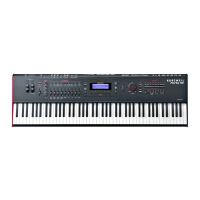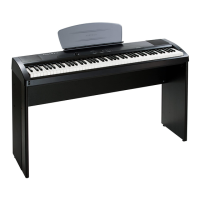KB3 Programs
Drawbars
D-2
Drawbars
e drawbars on a tone wheel organ emulate pipes of dierent lengths on a pipe organ. In
either case, they are controlled by changing the positions of a number of “stops”. As the
organist pulls out or pushes in these stops, he adds or reduces harmonics. Whether it’s pipes
or drawbars, though, the stops work like this: pull one out to add more of an overtone; push
it in to reduce the volume of the overtone.
e stops on the most popular tone wheel organs are: 16’, 5⅓’, 8’, 4’, 2⅔’, 2’, 1’, 1⅓’.
and 1’. Note that they are still measured in feet, a carryover from pipe organ days. e 16’
and 5⅓’ stops are considered the subharmonic group, while the third stop, 8’, produces the
fundamental of a tone, and stops 4-9 produce harmonics above the fundamental. By making
use of dierent combinations of these harmonics, a rich sort of additive synthesis is possible.
Best of all, you can make radical changes to the tone dynamically as you play.
e nine sliders of the Forte SE are set to control the drawbars. Pulling the slider towards
the keyboard increases the amount of the drawbar that is heard.
KB3 Mode Buttons
e nine buttons above the sliders on the Forte SE have special capabilities in KB3 Mode.
e functions are labeled in blue below the buttons. ese are:
Brake
Brake starts and stops the rotary speaker eect. is eect is not immediate, instead the
rotary speaker eect gradually slows down and speads up, in a similar way that a real rotary
speaker reacts.
Chorus/Vibrato
On/Off
is parameter turns the chorus or vibrato eect on and o.
Chor/Vib
is parameter determines which modulation eect is used. e choice is Vibrato or
Chorus.
Chorus/Vibrato Depth
is parameter determines how much of the eect is applied to the KB3 sounds. ere are
two levels of both Chorus and Vibrato available, depending on the setting for the Chor/Vib
button.

